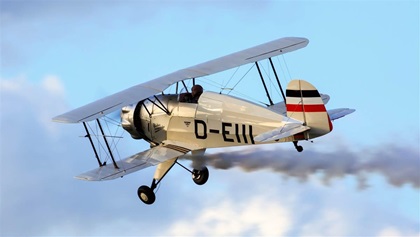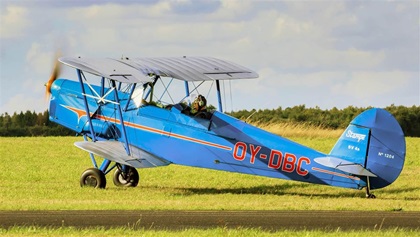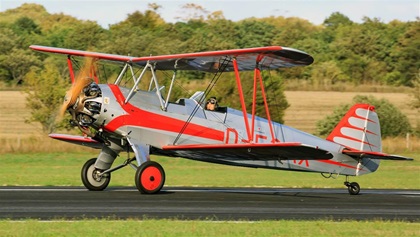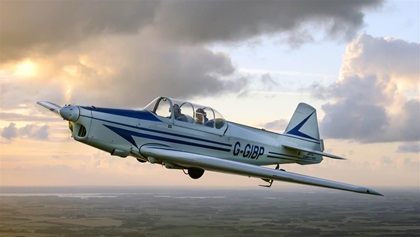The Big Dance
The Vintage Aerobatic World Championship showcases aircraft from another time
By Jonathan Apfelbaum
Photography by Julia and Jonathan Apfelbaum
When you think of aerobatics, what comes to mind? In today’s world, it is likely the roar and tumble of carbon-fiber unlimited monoplanes performing vision-dimming 10-G maneuvers. But the sport began with simple airplanes gracefully looping and rolling. In 2016, a group in Denmark felt their beloved antique aircraft were fading into the proverbial mists of time. They created an event to show the beauty and drama of aerobatics in the golden age of aviation: the Vintage Aerobatic World Championship (VAWC), now in its third year.

 The VAWC balances camaraderie with competitive excitement. “VAWC gives these fabulous old-time aircraft a new sense of purpose and reignites their proud owners and pilots,” said competitor Hardy Vad of Denmark. “VAWC unites the competitive and social spirit and gives a personal sense of going somewhere rather than retreating.”
The VAWC balances camaraderie with competitive excitement. “VAWC gives these fabulous old-time aircraft a new sense of purpose and reignites their proud owners and pilots,” said competitor Hardy Vad of Denmark. “VAWC unites the competitive and social spirit and gives a personal sense of going somewhere rather than retreating.”
Originally hosted in Stauning, Denmark, the VAWC found a new home in August 2018 in the picturesque fjordside town of Skive. While the competing pilots were from Europe, aviators and supporters from the United States, Australia, and South Africa contributed to the success of the event.
The aircraft themselves are diverse and eclectic (see “The Airplanes,” below). The Bücker Jungmanns and Jungmeisters were well represented, as well as Belgian Stampes. A Bölkow Junior 208, Saab 91B Safir, Focke-Wulf Fw 44 Stieglitz, SAI KZ VIII, and a Zlin 526 rounded out the field. Some of these aircraft are quite rare, with few examples built and fewer still flying. Taff Smith of the United Kingdom said of a Jungmeister: “It’s 85 years old, so we try and limit it to 3.5 Gs.”
The competition divides aircraft into three categories: Vintage (built before 1955), Classic (built between 1955 and 1970), and Replica (re-created or modified with modern engines). To level the playing field between the vintage aircraft and the power-advantaged replicas, the judging scores are weighted against the increased horsepower.
With any machine of this vintage, reliability and upkeep are always an issue. The United Kingdom team planned to have a four-ship formation display, but two of their aircraft developed mechanical issues. Several other registered aircraft were unable to make it for similar reasons. Keeping them flying is a labor of love—and there must be a lot of love, as there is a lot of labor.
August 16 was a practice day filled with coaching and critiquing. That evening, after a group dinner, several of the flying competitors kicked off the contest early with the Timewinder competition, modeling period-appropriate attire for their aircraft. All were invited to Aresti Dance their sequence, and hilarity ensued. Benoit Dierckx played it to the hilt, racing back and forth across the dance floor, thickening his French accent: “And ’ere, I make a loop, then a ’oll, oonless I forgeet! In which case, the judges don’t see that.”

By midmorning on Friday, the competition was well under way. Is there a more beautiful sight in aviation than an open-cockpit biplane looping, rolling, and spinning? Modern aerobatic aircraft can roll in excess of 400 degrees per second, snapping from maneuver to maneuver almost too quickly to register. There’s a different art to maneuvering these vintage aircraft. As Rainer Berndt of Germany said, “The Pitts may be the electric guitar, the Stratocaster, of aviation: all rock and roll. But the Bücker Jungmeister? It is the Stradivarius.”
The competition has three categories, each with increasing difficulty. First is Looping the Loop, combining a loop, wingover, turns, and rolls. It is designed to encourage participation, even if the aircraft has limited performance. Dancing the Cloverleaf combines a spin, loops, rolls, and a hammerhead. Last is Rolling the Circle, which combines a loop with a roll, hammerhead, and a rolling circle. Finally there is the Performance, a freestyle program that lets pilots showcase their skills with a routine of their own design choreographed to their musical choice. While the first three categories are graded by the three official judges, the Performance is evaluated by all pilots present. Each routine is assessed on flight harmony and romance, piloting skills, and creative flight concept, with the Performance including creative expression, program design, and music. In 2018, the VAWC added the Team Performance, a freestyle aerobatic formation category in which two teams competed.
Saturday brought lower ceilings, wind, and rain that limited the flying. The down time allowed for lectures and stories to be shared by the diverse group of contestants. As the mist set in on the airfield Saturday evening everyone was treated to a gourmet meal, part of an extravagant hangar party with a 20-piece big band orchestra. Before the celebration began, an awards ceremony recognized the top three competitors in each division with medals. First-place competitors received magnums of champagne as well as Bose A20 headsets.
The 2018 championships drew to a close with a scene resembling Casablanca: with champagne flowing, nostalgic swing and jazz tunes filling the air, dancing, and roars of laughter spilling through the hangar door into the dark mist illuminated by the airport beacon. At each turn, pilots talked of their beloved aircraft, about the beauty of flight, the sounds of a Tigre or Siemens engine, the joy of flying a biplane at sunset, or watching the world pivot and roll. These pilots are romantics, in love with the grace of aviation from a bygone era, with aircraft that require hand propping and copious amounts of oil to be wiped off after every flight. There is a magic here between the wooden wings and fabric, the engines that require grease every few hours, and the incredible history in their logbooks.
Jonathan Apfelbaum is an emergency physician and private pilot with seaplane, glider, and instrument ratings. He owns a Glastar with his wife, Julia.



 The Bü 133 Jungmeister (“Young Master”) was an advanced trainer of the same generation as the Bü 131, with similar tube, wood, and fabric construction. It was originally powered by a 160-horsepower Siemens-Bramo Sh 14A radial engine. Rainer Berndt describes it as “perfectly balanced” and easy to snap roll. Possibly the highest accolades were from Taff Smith, who after flying Mustangs and Spitfires says the Jungmeister is the perfect aircraft.
The Bü 133 Jungmeister (“Young Master”) was an advanced trainer of the same generation as the Bü 131, with similar tube, wood, and fabric construction. It was originally powered by a 160-horsepower Siemens-Bramo Sh 14A radial engine. Rainer Berndt describes it as “perfectly balanced” and easy to snap roll. Possibly the highest accolades were from Taff Smith, who after flying Mustangs and Spitfires says the Jungmeister is the perfect aircraft.  The Belgian SV.4 began production as an advanced aerobatic trainer in the 1930s. With its wood and fabric design it is sometimes called a “Belgian de Havilland” (or a “French Tiger Moth,” which isn’t accurate, as it is neither). The Stampe flies similarly to a Jungmann. With their well-harmonized controls Stampes are treasured by their caretakers. Unfortunately, parts are becoming harder to find, the wooden structure can be more sensitive to decay than metal, and there is an airworthiness directive requiring replacement of the lower-spar tie rods that can be onerous.
The Belgian SV.4 began production as an advanced aerobatic trainer in the 1930s. With its wood and fabric design it is sometimes called a “Belgian de Havilland” (or a “French Tiger Moth,” which isn’t accurate, as it is neither). The Stampe flies similarly to a Jungmann. With their well-harmonized controls Stampes are treasured by their caretakers. Unfortunately, parts are becoming harder to find, the wooden structure can be more sensitive to decay than metal, and there is an airworthiness directive requiring replacement of the lower-spar tie rods that can be onerous.  The rarest aircraft at the championship, the Stieglitz (“Goldfinch”) is a World War II German training aircraft that first flew in 1932. It was the first commercial success of the then-struggling Folke-Wulf. It is thought that every German Luftwaffe pilot flew the Stieglitz at some time during his career. An interesting side note is that a Fw 44 fuselage and engine was used as the basis for the first practical helicopter, the Focke-Wulf Fw 61. There are thought to be fewer than 50 in existence from more than 3,000 produced. Claus Cordes, who flew his Stieglitz in the VAWC, described it as “honest and responsible,” while being “softer” compared to a Jungmann. In the negative category, the roll rate is not particularly rapid, and every 10 hours the exposed pushrods and rocker arms need to be relubricated and the valve lash readjusted.
The rarest aircraft at the championship, the Stieglitz (“Goldfinch”) is a World War II German training aircraft that first flew in 1932. It was the first commercial success of the then-struggling Folke-Wulf. It is thought that every German Luftwaffe pilot flew the Stieglitz at some time during his career. An interesting side note is that a Fw 44 fuselage and engine was used as the basis for the first practical helicopter, the Focke-Wulf Fw 61. There are thought to be fewer than 50 in existence from more than 3,000 produced. Claus Cordes, who flew his Stieglitz in the VAWC, described it as “honest and responsible,” while being “softer” compared to a Jungmann. In the negative category, the roll rate is not particularly rapid, and every 10 hours the exposed pushrods and rocker arms need to be relubricated and the valve lash readjusted.  Czech pilots won the first FAI World Aerobatic Championship in 1960, leading their aircraft to become world leaders for the next several decades and transitioning the aerobatic world from biplanes to monoplanes. The foundation of this dynasty was the development of the Z 26 Tréner in 1946. The later Z 526 was designed in 1959. It is a strong classic design with excellent visibility through its large canopy and swept wings. It is light on the controls for such a large aircraft and is a reasonable cross-country traveler. Owners do have to be aware of the limited aerobatic life of 3,800 hours because of spar fatigue, and the brakes can be difficult to keep properly adjusted.—JA
Czech pilots won the first FAI World Aerobatic Championship in 1960, leading their aircraft to become world leaders for the next several decades and transitioning the aerobatic world from biplanes to monoplanes. The foundation of this dynasty was the development of the Z 26 Tréner in 1946. The later Z 526 was designed in 1959. It is a strong classic design with excellent visibility through its large canopy and swept wings. It is light on the controls for such a large aircraft and is a reasonable cross-country traveler. Owners do have to be aware of the limited aerobatic life of 3,800 hours because of spar fatigue, and the brakes can be difficult to keep properly adjusted.—JA 